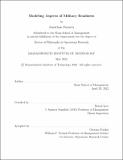| dc.contributor.advisor | Levi, Retsef | |
| dc.contributor.author | Paynter, Jonathan | |
| dc.date.accessioned | 2022-08-29T16:12:51Z | |
| dc.date.available | 2022-08-29T16:12:51Z | |
| dc.date.issued | 2022-05 | |
| dc.date.submitted | 2022-07-05T19:56:45.301Z | |
| dc.identifier.uri | https://hdl.handle.net/1721.1/144804 | |
| dc.description.abstract | During peacetime, military performance assessment focuses on combat readiness. This thesis focuses on applying tools from operations research to inform and optimize strategic design decisions as well as operational decisions related to military readiness. In particular, we use a variety of optimization techniques to determine how to enhance equipping and personnel readiness and to quantify important trade-offs between personnel readiness and leader development.
Chapter 2 focuses on helicopter maintenance scheduling and is motivated by Department of Defense investment in predictive analytics for component health. We develop an index-style decision policy for integrating signal-based pre-emptive component repairs with the recurring time-based preventive maintenance tasks for the overall, multi-component system. The results highlight that the predictive model generating the component health signal must have exceptionally low false positive rates, 5% or less for use-case settings, or the pre-emptive repair decision policy will actually hurt equipment readiness. Chapter 3 models the impact of career path design policy on personnel readiness. To develop leaders for future assignments, the military implements career path design policy that restricts the sequencing and timing of an individual's assignments. Overly restrictive policy can hurt personnel readiness even when the overall system has enough personnel for every assignment. We develop a mixed integer linear programming formulation and a column-generation inspired algorithm to determine specific changes to the career path design policy that enhance readiness. For a specific U.S. Army officer career field we show how a small change in career path design policy can provide a 9% increase in personnel readiness. Chapter 4 considers the U.S. Army's recently updated assignment process that includes a matching market for the thousands of officers moving to new jobs every year. When there are more available jobs than officers, a personnel manager assesses personnel readiness to decide which jobs enter the market, and then assignments are determined by a deferred acceptance algorithm to maximize applicant satisfaction. We develop a mixed integer formulation that combines these decisions and can be used to generate a Pareto frontier between personnel readiness and applicant satisfaction. Then, we develop a tractable solution approach for finding an approximate Pareto frontier using a local search algorithm. We use data from the U.S. Army's 2020 assignment market to show how a 2% decrease in readiness provides room for a 10-20% increase in officer assignment satisfaction. | |
| dc.publisher | Massachusetts Institute of Technology | |
| dc.rights | In Copyright - Educational Use Permitted | |
| dc.rights | Copyright MIT | |
| dc.rights.uri | http://rightsstatements.org/page/InC-EDU/1.0/ | |
| dc.title | Modeling Aspects of Military Readiness | |
| dc.type | Thesis | |
| dc.description.degree | Ph.D. | |
| dc.contributor.department | Massachusetts Institute of Technology. Operations Research Center | |
| mit.thesis.degree | Doctoral | |
| thesis.degree.name | Doctor of Philosophy | |
